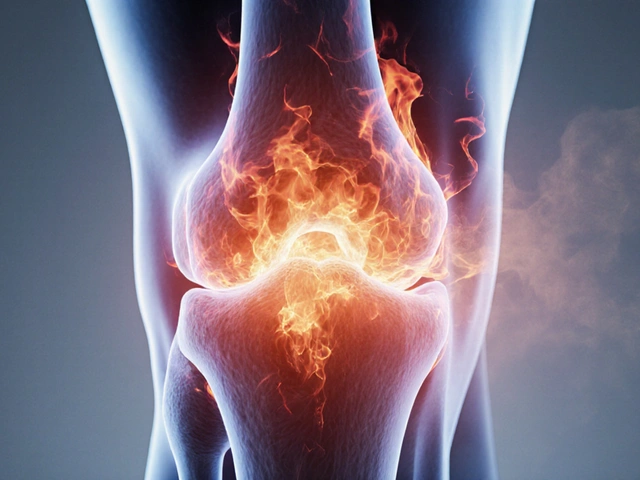
Alpha-1 Blocker Side Effect Comparison Tool
Results for
| Medication | Side Effect Rate | Management Tips |
|---|---|---|
| Alfuzosin | ||
| Tamsulosin | ||
| Silodosin |
Quick Takeaways
- Alfuzosin can cause dizziness, headache, and nasal congestion in up to 10% of users.
- Serious events like orthostatic hypotension or retrograde ejaculation are rarer but need prompt attention.
- Most side effects are manageable with timing adjustments, hydration, and monitoring.
- Check for drug interactions, especially with CYP3D4 inhibitors.
- Contact your clinician if symptoms persist or worsen.
When a doctor prescribes Alfuzosin is an oral alpha‑1 blocker used to relax the muscles in the prostate and bladder neck, easing urinary flow in men with benign prostatic hyperplasia (BPH), the goal is to improve quality of life. But like any medication, it can bring unwanted effects. This guide walks you through the most common (and some rare) side effects, explains why they happen, and gives practical steps to keep them under control.
How Alfuzosin Works
Alfuzosin belongs to the Alpha‑1 blocker class. It blocks alpha‑1 adrenergic receptors in the smooth muscle of the prostate and bladder neck. By doing so, it reduces muscle tone, allowing urine to flow more freely. Unlike some other alpha blockers, alfuzosin is relatively selective for the prostate, which means fewer cardiovascular effects for most men.
Common Side Effects (1 in 10 to 1 in 100)
These are the side effects you’re most likely to notice during the first few weeks:
- Dizziness - Often feels like the room is spinning, especially when you stand up quickly.
- Headache - A dull, steady ache that may improve after a few days.
- Nasal congestion - A stuffy feeling that can make breathing at night tougher.
- Flushing - Warm, reddened skin, usually on the face or neck.
- Abdominal discomfort - Mild cramps or a “full” sensation.
Most of these settle on their own as your body gets used to the medication.
Less Common but Notable Effects
These occur in less than 1% of users, but they’re worth watching:
- Orthostatic hypotension - A sudden drop in blood pressure when you stand, leading to light‑headedness or fainting.
- Retrograde ejaculation - Semen flows backward into the bladder instead of out the penis. This does not affect sexual pleasure, but it can impact fertility.
- Palpitations - A feeling of a racing or irregular heartbeat.
Rare Serious Reactions
These are seen in fewer than 1 in 1,000 patients. If any of them appear, seek medical help immediately:
- Severe hypotension that does not improve with lying down.
- Allergic reactions: rash, itching, swelling, or trouble breathing.
- Chest pain or signs of a heart attack.

Why Do These Side Effects Occur?
Alfuzosin’s main job is to relax smooth muscle. That same action can affect tiny blood vessels in the nose, head, and skin, leading to congestion, headache, or flushing. The drug also influences the sympathetic nervous system, which is why some people feel dizzy when they change positions abruptly.
Managing Common Side Effects
- Take it with food. Eating a small snack can blunt the peak concentration that often triggers dizziness.
- Rise slowly. When getting out of bed, sit up for a minute, then stand. This gives blood pressure time to adjust.
- Stay hydrated. Aim for at least 2 liters of water daily unless your doctor advises otherwise.
- Use saline nasal spray. For congestion, a salt‑water spray can clear nasal passages without medication.
- Over‑the‑counter pain relievers. Acetaminophen can ease mild headaches; avoid NSAIDs if you have stomach ulcers.
If symptoms persist after a week, call your clinician. They may lower the dose or switch you to a different alpha‑1 blocker.
When to Adjust the Dose or Switch Medications
Alfuzosin is commonly prescribed at 10mg once daily. However, some men benefit from a reduced dose (5mg) if they experience persistent dizziness or low blood pressure. Your doctor might also consider alternatives such as Tamsulosin or Silodosin, which have slightly different side‑effect profiles.
Comparison of Alfuzosin with Other Alpha‑1 Blockers
| Side Effect | Alfuzosin | Tamsulosin | Silodosin |
|---|---|---|---|
| Dizziness | 8‑10% | 5‑7% | 6‑8% |
| Orthostatic hypotension | 1‑2% | 0.5‑1% | 1‑1.5% |
| Retrograde ejaculation | 2‑3% | 1‑2% | 4‑5% |
| Nasal congestion | 6‑9% | 4‑6% | 5‑7% |
The table shows that while all three drugs share similar side‑effect patterns, the exact rates differ. Your doctor will choose the one that best matches your health profile.

Drug Interactions to Watch
Alfuzosin is metabolized mainly by the liver enzyme CYP3D4. Medications that inhibit this enzyme can raise alfuzosin levels and increase side‑effect risk. Common culprits include:
- Ketoconazole (antifungal)
- Erythromycin (antibiotic)
- Ritonavir (HIV protease inhibitor)
- Fluoxetine or paroxetine (SSRIs)
If you’re on any of these, your doctor may adjust the alfuzosin dose or pick a different BPH therapy.
Monitoring and Follow‑Up
Good communication with your healthcare team helps catch problems early. Here’s a simple schedule:
- First week: Note any dizziness, headaches, or nasal stuffiness. Keep a brief diary.
- Two‑week check‑in: Call or email your clinician to discuss the diary. They may suggest a dose tweak.
- One‑month review: Blood pressure measurement (lying and standing) and a brief physical exam.
- Every three months: Review urinary symptoms, side‑effect burden, and any new medications you’ve started.
These checkpoints keep the treatment effective while minimizing discomfort.
When to Seek Immediate Help
If you notice any of the following, treat them as emergencies:
- Severe dizziness that leads to falls.
- Chest pain, shortness of breath, or palpitations that feel abnormal.
- Swelling of the face, lips, tongue, or throat.
- Sudden loss of vision or fainting.
Call 911 or head to the nearest emergency department.
Bottom Line
Alfuzosin can be a game‑changer for men battling BPH, but like any drug, it brings a side‑effect package. Most issues are mild, temporary, and manageable with simple tricks-taking the pill with food, standing up slowly, staying hydrated, and watching for drug interactions. Keep a line of communication open with your clinician, and you’ll likely stay on the path to smoother urination without unnecessary discomfort.
Frequently Asked Questions
Can I take alfuzosin with nitrates?
No. Combining alfuzosin with nitrate medications (often used for chest pain) can cause a dangerous drop in blood pressure. Your doctor will avoid this combo.
Is it safe to drink alcohol while on alfuzosin?
Alcohol can increase the risk of dizziness and low blood pressure. If you choose to drink, keep it minimal and monitor how you feel.
How long does it take for alfuzosin to improve urinary symptoms?
Most men notice improvement within 1‑2 weeks, but full benefits may take up to 4‑6 weeks of consistent use.
Do I need to stop alfuzosin before surgery?
Yes. Surgeons usually ask patients to discontinue alfuzosin at least 24‑48 hours before any procedure that involves anesthesia, to avoid sudden blood‑pressure changes.
Can the medication cause erectile dysfunction?
Erectile dysfunction is not a common side effect of alfuzosin. However, if you experience any persistent changes in sexual function, discuss them with your doctor.
Write a comment
Your email address will not be published.





8 Comments
Starting a new BPH med can feel a bit daunting, but the body usually finds its rhythm within a week or two.
If you notice a light‑headed spin when you get up, try pausing at the edge of the bed for a minute before standing – it makes a huge difference.
Keeping a water bottle handy helps with both hydration and flushing out any lingering stuffiness.
When the headache nags, a simple acetaminophen can calm it down without messing with your stomach.
Remember, most side effects are transient, so give it a solid two weeks before deciding it’s a deal‑breaker.
Don’t be fooled by the glossy brochure – the dizziness isn’t just a mild inconvenience, it can knock you flat if you ignore it.
Pushback on any lingering headache and you’ll keep the drug’s benefits alive.
If the nasal congestion becomes a night‑time nightmare, demand a proper nasal spray from your doctor now.
Looks like Alfuzosin does its job for most lads, but the flushing and stuffiness can feel a bit like a summer afternoon stuck in a sauna.
Just give it a solid fortnight, and most of the signs will mellow out.
Having a light snack with the pill is a neat trick – it smooths out the peak that can trigger light‑headedness.
If you’re on any of those CYP3D4 inhibitors, a quick chat with your GP can save you a lot of hassle.
WOW!!! This medication can turn your mornings into a roller‑coaster of dizziness and flushing!!!
YOU MUST STAND SLOWLY, TAKE IT WITH FOOD, AND KEEP THAT WATER BOTTLE LIKE IT’S YOUR LIFE‑SAVER!!!
AND IF YOU’RE ON ANY OF THOSE NASTY CYP3D4 INHIBITORS, STOP THEM OR YOU’LL BE IN FOR A TERRIBLE RIDE!!!
DON’T LET A LITTLE CONGESTION KEEP YOU FROM LIVING – PUSH FOR A SALINE SPRAY OR A DOCTOR’S NOTE ASAP!!!
Alfuzosin acts as an α1‑adrenergic antagonist reducing prostatic smooth muscle tone resulting in decreased outflow resistance side effects stem from systemic vasodilation orthostatic hypotension may occur therefore advise gradual positional changes hydration status monitoring recommended
Starting alfuzosin can be a bit of a learning curve, but most guys settle in quickly.
The first few days you might feel a little woozy when you hop out of bed, which is totally normal.
A simple trick is to sit up on the edge of the mattress for a minute before standing up fully.
Drinking a good glass of water right after the dose can also help keep your blood pressure steady.
If you get a mild headache, acetaminophen usually does the job without irritating your stomach.
Nasal congestion can be annoying at night, but a saline spray clears the passages in minutes.
Eating a small snack with the pill blunts the peak concentration and often eases the dizziness.
Most of the side effects fade within two weeks, so give it a fair trial before making changes.
Keep track of any symptoms in a short diary – it makes your follow‑up visit much more productive.
If you notice a sudden drop in blood pressure that doesn’t improve lying down, call your clinician right away.
Retrograde ejaculation is uncommon but worth knowing about if you’re planning a family.
Drug interactions with CYP3D4 inhibitors like ketoconazole can raise levels, so double‑check any new meds.
Your doctor might lower the dose to 5 mg if the dizziness persists beyond a week.
In that case, alternatives like tamsulosin or silodosin could be considered.
Stay positive, stay hydrated, and you’ll likely see smoother urination without major hassles 😊👍.
Seriously, if that’s your “solution,” you’re just buying time.
Hydration and slow standing are key.